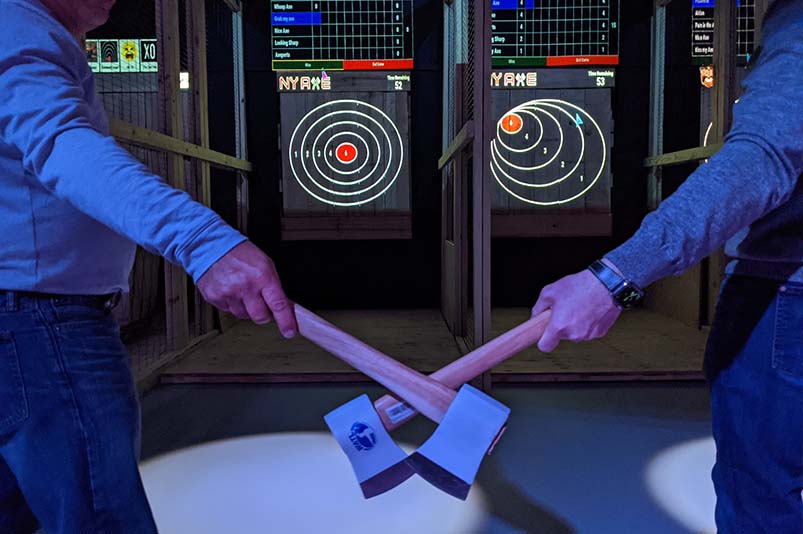The Enjoyable of Axe Throwing: Just How This Sporting Activity Combines Ability and Adrenaline for a Great Time
Axe throwing has become a captivating sporting activity that masterfully links the need for precise skill with the rush of adrenaline, offering individuals a engaging and one-of-a-kind experience. The act of tossing an axe in the direction of a target requires concentration and strategy, simultaneously cultivating an environment of camaraderie and pleasant competition. This interesting mix of psychological focus and physical effort has made axe tossing a popular option for those looking for both entertainment and a sense of accomplishment. To truly value the depth and appeal of this task, one need to consider its origins, the required tools, and the fundamental methods that guarantee both safety and security and pleasure.
The Origins of Axe Throwing
Axe tossing, a leisure task that has acquired significant popularity in recent years, traces its roots back to ancient times. The earliest documents of axe usage in affordable contexts are discovered amongst the Celts and Vikings, that threw axes for sporting activity as well as in battle training.
Medieval European warriors, particularly throughout the Middle Ages, exercised axe throwing as part of their martial training. The Francisca, a sort of throwing axe made use of by the Franks, ended up being legendary for its fatal accuracy. This traditional weapon was created to be thrown at opponent shields and armor, showcasing its dual energy in both sporting activity and fight.
In even more recent background, axe throwing saw a revival in the logging camps of North America in the 20th and 19th centuries. Lumberjacks would engage in pleasant competition, testing their precision and strength by targeting at wood targets. This development from a survival skill to a leisure activity has paved the method for its modern-day renewal, with devoted locations and organizations now commemorating the sporting activity globally.
Devices You Required
Understanding the rich history of axe tossing boosts the recognition of the sporting activity's modern iteration. For competitive and leisure axe throwing, the most generally used kind is the hatchet, generally considering between 1.25 to 2 pounds with a manage length of around 16 inches.
Equally crucial is the target. Law targets are created from wood, with softwood ranges like pine or cottonwood being liked for their capacity to hold the axe and take in. The target is generally divided into five concentric circles, each with a certain factor value, to facilitate scoring.
Safety gear, though usually ignored, is vital. Safety gloves can enhance grasp and avoid blisters, while closed-toed shoes are a must to secure feet from gone down axes (ax throwing denver). A well-lit, roomy throwing location, full with security barriers, makes certain a regulated environment where participants can focus on honing their abilities.
Basic Techniques Described
Understanding the fundamental strategies of axe throwing is crucial for both security and proficiency. The very first strategy to recognize is the hold. Hold the axe with a firm, yet unwinded hold, similar to holding a golf club. The dominant hand should see page be placed directly below the axe head, while the non-dominant hand sustains completion of the manage.
Following, concentrate on the position. Stand with your feet shoulder-width apart, guaranteeing your body is stabilized. Your leading foot must be slightly ahead, aligning with your target. This positioning aids in keeping stability and routing power precisely in the direction of the target.

Safety And Security First
Making sure safety in axe throwing is paramount to developing an injury-free and pleasurable experience. A well-designed axe throwing center attributes clear demarcations in between tossing lanes, tough backdrops to capture stray axes, and non-slip flooring to prevent accidents.
Advantages of Axe Throwing
Axe tossing deals a myriad of advantages that prolong beyond easy entertainment. Physically, it gives a full-body exercise, involving muscle mass in the arms, shoulders, back, and core. The repeated activity of throwing the axe likewise improves hand-eye control and great motor abilities. For those wanting to enhance their overall fitness, axe throwing can offer as a appealing and dynamic form of workout.
Psychologically, axe tossing requires precision, method, and focus, making it an excellent method to develop cognitive skills. The focus required to hit the target can function as a form of mindfulness, enabling individuals to clear their minds and reduce anxiety. This psychological involvement can be particularly useful in helping people develop far better problem-solving abilities and mental strength.
Socially, axe throwing is typically enjoyed in team setups, promoting team-building and sociability. Whether as part of a business occasion or a casual trip with friends, the sport urges communication and cooperation. In addition, the public experience of discovering and improving with each other can reinforce partnerships and develop lasting memories.
Verdict

The earliest records of axe use in competitive contexts are located among the Celts and Vikings, who threw axes for sporting activity as well as in combat training. Release the axe when your hands are roughly at eye degree, permitting the axe's all-natural turning to direct it in the direction of the target.
A well-designed axe throwing facility attributes clear separations in between throwing lanes, strong backgrounds to capture roaming axes, and non-slip flooring to stop crashes. Individuals must be instructed on the correct way to web link handle and toss the axe, emphasizing regulated, calculated movements over forceful throws.
In summary, axe tossing stands out as a sporting activity that masterfully integrates precision, skill, and adrenaline.